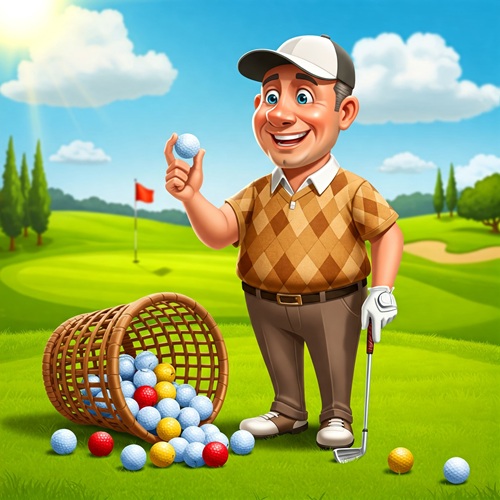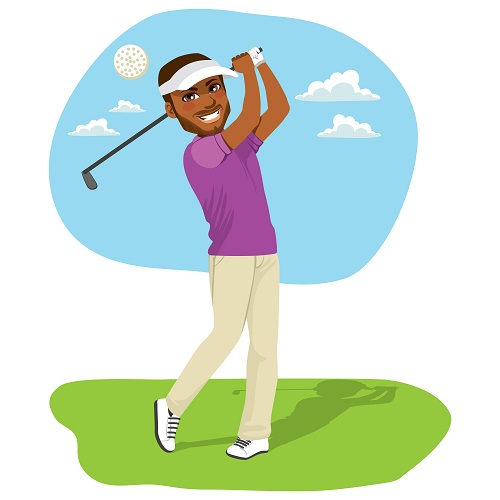Types of Golf Balls
Selecting the right golf ball can significantly impact your performance on the course.
With numerous options from top golf ball brands like Titleist, Callaway, and TaylorMade, finding the perfect golf ball for your game can be overwhelming.
Whether you have faster swing speeds like a seasoned pro or are just beginning with slower swing speeds, understanding the different types of golf balls is crucial.
This guide will help you navigate various types of golf balls and the features you need to match the right ball to your playing style, skill level, and specific needs on the course.

Table of Contents
CHAPTER 1
Understanding Golf Ball Components
Golf balls consist of two main components: the cover and the core/mantle. The core, typically made of rubber or a liquid center, affects the ball’s speed, spin, and launch.
Premium golf balls feature advanced core technology designed for optimal energy transfer at impact.
The mantle layer seals the center from moisture and helps retain energy after impact. It is often made of soft, synthetic rubber. Multi-layer balls such as the TaylorMade TP5x utilize specialized mantle layers to enhance performance.
The cover represents one of the two main cover types: ionomer or urethane.
Ionomer covers, found in balls like the Callaway Supersoft, offer durability and less spin, making them ideal for beginners or golfers who need distance.
Urethane covers, featured in the Bridgestone Tour B and Titleist Pro V1x, provide a softer feel and better control, particularly beneficial for wedge and approach shots.
CHAPTER 2
Four Types of Golf Ball Construction
Golf balls come in various constructions, each designed to offer specific benefits to players.
Two-piece balls consist of a large solid core covered by a durable outer layer. The Srixon Soft Feel exemplifies this construction, offering good distance and durability for average golfers with moderate swing speeds.
Three-piece ball designs like the Titleist AVX feature an additional layer between the core and cover.
This construction provides more spin control and a softer feel compared to two-piece balls, benefiting mid-handicappers who need a balance of distance and control.
Four and five-piece golf balls, such as the Vice Pro Plus and Callaway Chrome Tour, represent the most technologically advanced options.
These multi-layer balls provide precise performance characteristics for different shots, offering high spin for greenside control and lower spin for distance off the tee.
CHAPTER 3
Golf Ball Performance: What to Consider
Golf balls are grouped into four performance categories based on handicap and skill level.
Tour performance balls like the Titleist Pro V1 and Pro V1x are premium options designed for scratch golfers with faster swing speeds. They offer exceptional control and feel around the greens.
Tour value balls offer similar technology at a lower price point, suitable for low- to mid-handicappers. The Mizuno Pro X falls into this category, providing professional-level performance at a more accessible price.
Soft distance two-piece golf balls emphasize greenside spin and feel while maintaining good distance. The Bridgestone e6 Soft symbolizes this category, providing a softer feel with reasonable distance for slower swing speeds.
Straight distance balls focus on producing longer, straighter drives. These typically feature two-piece construction with high compression cores, which is ideal for golfers who need more distance.
CHAPTER 4
Choosing a Ball for Your Game
Selecting the right golf ball depends on your skill level, swing speed, and playing style:
Beginners and high-handicap golfers benefit from more forgiving two-piece options like the Srixon Soft Feel, which offers distance and durability with lower compression for slower swingers.
Advanced players and mid-handicappers often prefer multi-layer options like the Bridgestone Tour B, which provides more control for approach and wedge shots.
Consider your short-game needs first, as most scoring opportunities happen around the green. If you struggle with control near the pin, urethane covers offer high spin for better wedge control.
Experiment with different types of golf balls to find what works best for your game. Many manufacturers offer variety packs or custom golf balls to help you determine your preference.
CHAPTER 5
Professional Golfers’ Preferences
Pro players typically prefer high-performance golf balls with advanced technology.
The two Titleist golf balls are among the most popular choices on professional tours, offering exceptional control, consistent flight, and optimal spin rates.
Other top golf ball brands like TaylorMade with their Tour Response Stripe and Callaway with the ERC Soft also have strong representation among tour players, each providing unique performance characteristics that match specific player preferences.
CHAPTER 6
Tips for Selecting the Perfect Golf Ball
Faster swing speeds generally work well with higher compression balls while slower swing speeds benefit from lower compression offerings.
If you prioritize distance, two-piece balls with ionomer covers, like the Titleist TruFeel may be best. If you need more control, urethane-covered multi-layer balls provide more spin for approach shots.
Try the Titleist AVX if you want lower spin with the driver but still need greenside control or the Vice Pro if you’re looking for tour performance at a lower price point.
While the Bridgestone Tour B series might be perfect for a professional golfer, average golfers with moderate swing speeds might find better value and performance from balls designed specifically for their game.
By understanding the technology behind different types of golf balls and considering your playing style, you can select the perfect golf ball to improve your performance and enjoyment on the course.
CHAPTER 7
Frequently Asked Questions
What are the different types of golf balls?
Golf balls come in four main construction types: one-piece (basic practice balls), two-piece (distance-focused with durable covers), three-piece (balanced performance with additional mantle layer), and multi-layer (four or five-piece premium balls offering specialized performance).
Do soft or hard golf balls go farther?
Hard golf balls typically travel farther for players with faster swing speeds because they compress less, resulting in more energy transfer and less spin.
The best soft golf balls may provide more distance for players with slower swing speeds as they can achieve better compression.
How do I know which golf ball to use?
Choose a golf ball based on your skill level, swing speed, and playing style. Beginners benefit from two-piece distance balls, while advanced players often prefer multi-layer urethane-covered balls.
Our rule of thumb is always to consider your short-game needs first, then test several options.
Will a 100 compression ball go farther than a 90 compression ball?
For players with swing speeds over 100 mph, a 100 compression ball will likely go farther because they can properly compress it.
For average or slower swing speeds, a 90 compression ball provides more distance since it will compress more efficiently with less power.






